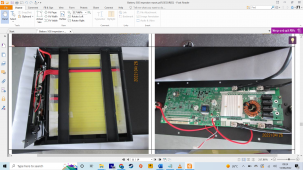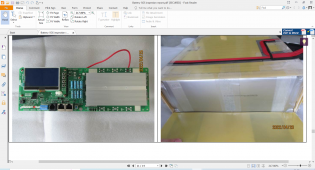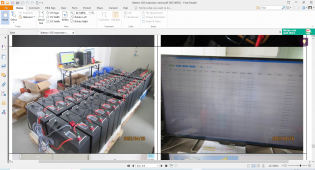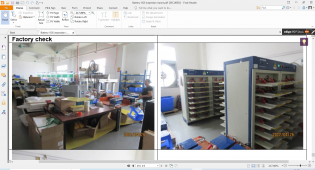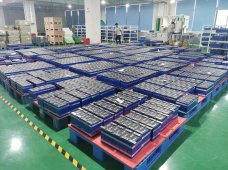Hey guys, in April 2022 I purchased 3 of the following LifePo4 batteries: Cerrnss 48V 100AH SMART TYPE Nominal Capacity:5Kwh (32 Parallel),Nominal Voltage:48V (Built-in 16S Smart BMS). They were purchased from Shenzhen Hyuan International Trade Co., Ltd on Alibaba.
I currently have a 9kwh solar PV system with hybrid 6Kwh Solis (Ginlong) inverter, now with batteries integrated in the system. A video of the battery system wired and installed can be viewed at https://drive.google.com/file/d/1QntgW8-gBySf5jelZFA_VTKpJhtjFFYj/view?usp=sharing
Before purchase I was looking into potentially installing the Li-ion batteries of an old Leaf as battery wall for the house but the price seemed to be quite expensive when compared to many benefits of a lifepo4 battery such as many (many!) more life cycles and the general inability to self ignite!. I was initially looking at the Cerrnss batteries on aliexpress, specifically the 100ah 24V but then decided to check for options on Alibaba. The same company that produces the Cerrnss batteries and sells them on Aliexpress also produced a 5kwh battery module that I eventually bought. It took just over 3 months from purchase to arrival at my door.
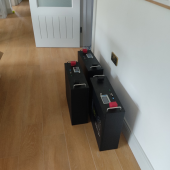
Before shipping I organised a 3rd party independent inspection by SGS, a certification body that does such inspections on the Alibaba platform for an extra cost (180 USD). As they are independent, this is the way to go if you are spending serious money on it (I spent 3,684 USD on the batteries including 1,100 USD of shipping costs to Europe in April 2022). Before the batteries were fully built and completed an inspector went and inspected the factory and the batteries in a day. I had specific questions for him such as to make sure that the cells used in the batteries were new, testing the actual voltage and amperage of the batteries, among a long list of other questions.
The inspector got most of the factory workers to get together and to wire 32 of these batteries in parallel since that was one of the advertised specifications. The seller complied although it was a mighty job since every battery weight nearly 50 kg/100 lb and most of them were already packaged for shipping to various customers. However, everything worked out fine and the inspector was shown the results of the 32 strong parallel connection. I can sympathise with the seller after having received the batteries and having installed them in the garage - they are very heavy, no doubts there.
The inspector found two faults in the inspection, one was that they used an old sticker in the battery case that showed outdated specs relating to the number of battery cycles and the other issue related to the picture in the ad showing two positive and two negative terminals per battery module, although there is only one of each. All in all I wasn’t overly concerned as these were more advertising/cosmetic issues rather than actual physical, quality or manufacture issues with the batteries. I think the battery cycle advertised (Cycle life (80%DOD): ≥4000 cycles) are probably true enough to reality even if the seller based his claim on the stats and tests provided by the cell supplier (CATL) rather than an actual test in the factory. You have to make some small compromises for a cost saving, which these batteries had, compared to other options I could have bought in Europe - all quite overpriced in my humble opinion.
Before the inspection I enquired about the nature and sourcing of the cells they used and the answer given was CATL, and I was supplied a picture or two of such cells and the codes. The engineer said that CATL's cells do not have a logo, but the brand-new cells will have a QR code that can be scanned. Based on what they said, this is CATL's internal barcode:
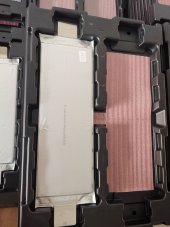
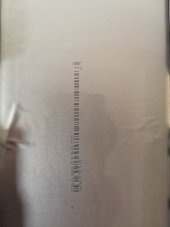

Does any of you know of the CATL codes? Can you confirm these are CATL cell codes?
After the SGS inspection I was much more at ease in that: 1 the factory existed, 2: the batteries were of very good build quality, 3: the specs advertised checked out, 4: no other issues/red flags with the staff, the factory or the batteries were highlighted by the inspector.
Fast forward 2.5 months and I receive the batteries. The unboxing was exciting - solid black metal boxes weighting 50 kg each and looking great. I pressed the on button in each battery and the display loaded up the key parameters. All batteries were storing around 107-109ah which I thought was a good sign. I was reading online that a second hand lifepo4 cell that may have undergone 500-600 cycles already (usually sold to second life user between 500 and 1000 cycles), and may only show 95% of the total ah potential.
I brought the batteries to the garage and connected them in parallel, as shown below, positive to positive terminals, and negative to negative terminals – with each cable leading to the respective positive/negative attachment of the inverter.
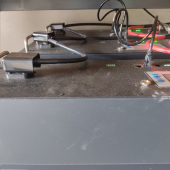
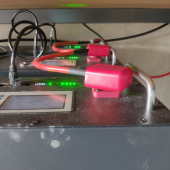
After having connected the CAN cables from battery to battery and then from the 3rd battery to the inverter I couldn’t see any battery recognition from the inverter. Of the various "Battery Select" settings (i.e. select which type or brand of battery you have connected) pre-programmed in the inverter I used "User Define" as this battery was not in the list and I could customise all charge and discharge parameters (i.e. key communication thresholds between inverter and battery system). Turns out the issue of recognition had to do with properly setting the 6 little white switches in each battery battery module.
You need to set these up in a specific order, as highlighted in one of the tables in the battery manual, so that they correctly communicate with the inverter and also among the other batteries.
These batteries are set up as master and slave/s. The master battery has a code, while the slave or secondary batteries have other codes that you need to key in. It’s not hard, you just need the manual to do that. However, since I hadn’t received the manual in the box, I didn’t know how to do that and wasn't sure what the buttons did. The seller was very useful across hundreds of questions I asked and helped me all throughout the installation process. The manual was forwarded as a PDF after I requested it. The main thing I needed help with was setting the parameters for the battery in the User Define battery mode where you have to set up voltage and currents between the inverter and the battery so that the inverter sends the right amount of electricity to the battery and doesn’t trip the battery BMS, and viceversa. To set up those parameters optimally it took me about a week of back and forth with the seller, mainly because the Solis inverter manual is not overly precise in explaining what each parameter actually means and so I had to speak to Solis staff in Europe to clarify the meaning of a few parameters. Anyhow, we eventually managed to get through this and I was supplied with all the relevant parameter values. Being a biologist myself and not by any means an expert in electrical stuff it took me a little while to read up and understand that the values provided made sense and were generally applicable to a battery with this voltage and amperage.
The battery BMS got tripped only once in the past 4 weeks of operation, and to fix it I lowered the parameters for max ah discharge from 100 to 97 ah, and lowered the max charge voltage from 58 V to 57.8 V, and increased the minimum charge voltage from 43.2 to 43.4 V. Since making those changes the battery and inverter seemed to have communicated fine without tripping any alarm on either side. Based on these parameters I noticed that can discharge a maximum load of 5Kwh from the batteries and if the house load is higher - then there is either the PV supplying the balance, or the grid. The picture below shows the current setting for the battery after all my back and forth with Solis, the seller and my experience with tripping the BMS alarm.
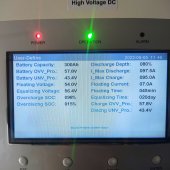
All in all, the system is working great, we are putting all the excess solar energy we don’t use during the day in the battery, while the excess goes to the grid, and from the evening till early morning the 15kwh battery supplies all the energy we need. We are pretty much off grid now (in Ireland) noting that we still export 25-40 Kwh to the grid, daily after the battery has been charged and discharged daily. We wont be so lucky in the winter but the plan is to buy back the energy exported in spring and summer and hopefully get to a net zero annual balance, or better.
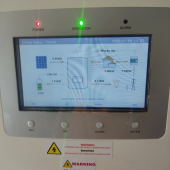
If you are thinking of buying some well-priced lifepo4 batteries from a Chinese supplier I would recommend the Cerrnss lifepo4 batteries from Shenzhen Hyuan International Trade Co., Ltd. Once again, a video of the battery system wired and installed can be viewed at https://drive.google.com/file/d/1QntgW8-gBySf5jelZFA_VTKpJhtjFFYj/view?usp=sharing
Hoping this may be of help.
Cheers and good luck to you.
V
I currently have a 9kwh solar PV system with hybrid 6Kwh Solis (Ginlong) inverter, now with batteries integrated in the system. A video of the battery system wired and installed can be viewed at https://drive.google.com/file/d/1QntgW8-gBySf5jelZFA_VTKpJhtjFFYj/view?usp=sharing
Before purchase I was looking into potentially installing the Li-ion batteries of an old Leaf as battery wall for the house but the price seemed to be quite expensive when compared to many benefits of a lifepo4 battery such as many (many!) more life cycles and the general inability to self ignite!. I was initially looking at the Cerrnss batteries on aliexpress, specifically the 100ah 24V but then decided to check for options on Alibaba. The same company that produces the Cerrnss batteries and sells them on Aliexpress also produced a 5kwh battery module that I eventually bought. It took just over 3 months from purchase to arrival at my door.

Before shipping I organised a 3rd party independent inspection by SGS, a certification body that does such inspections on the Alibaba platform for an extra cost (180 USD). As they are independent, this is the way to go if you are spending serious money on it (I spent 3,684 USD on the batteries including 1,100 USD of shipping costs to Europe in April 2022). Before the batteries were fully built and completed an inspector went and inspected the factory and the batteries in a day. I had specific questions for him such as to make sure that the cells used in the batteries were new, testing the actual voltage and amperage of the batteries, among a long list of other questions.
The inspector got most of the factory workers to get together and to wire 32 of these batteries in parallel since that was one of the advertised specifications. The seller complied although it was a mighty job since every battery weight nearly 50 kg/100 lb and most of them were already packaged for shipping to various customers. However, everything worked out fine and the inspector was shown the results of the 32 strong parallel connection. I can sympathise with the seller after having received the batteries and having installed them in the garage - they are very heavy, no doubts there.
The inspector found two faults in the inspection, one was that they used an old sticker in the battery case that showed outdated specs relating to the number of battery cycles and the other issue related to the picture in the ad showing two positive and two negative terminals per battery module, although there is only one of each. All in all I wasn’t overly concerned as these were more advertising/cosmetic issues rather than actual physical, quality or manufacture issues with the batteries. I think the battery cycle advertised (Cycle life (80%DOD): ≥4000 cycles) are probably true enough to reality even if the seller based his claim on the stats and tests provided by the cell supplier (CATL) rather than an actual test in the factory. You have to make some small compromises for a cost saving, which these batteries had, compared to other options I could have bought in Europe - all quite overpriced in my humble opinion.
Before the inspection I enquired about the nature and sourcing of the cells they used and the answer given was CATL, and I was supplied a picture or two of such cells and the codes. The engineer said that CATL's cells do not have a logo, but the brand-new cells will have a QR code that can be scanned. Based on what they said, this is CATL's internal barcode:



Does any of you know of the CATL codes? Can you confirm these are CATL cell codes?
After the SGS inspection I was much more at ease in that: 1 the factory existed, 2: the batteries were of very good build quality, 3: the specs advertised checked out, 4: no other issues/red flags with the staff, the factory or the batteries were highlighted by the inspector.
Fast forward 2.5 months and I receive the batteries. The unboxing was exciting - solid black metal boxes weighting 50 kg each and looking great. I pressed the on button in each battery and the display loaded up the key parameters. All batteries were storing around 107-109ah which I thought was a good sign. I was reading online that a second hand lifepo4 cell that may have undergone 500-600 cycles already (usually sold to second life user between 500 and 1000 cycles), and may only show 95% of the total ah potential.
I brought the batteries to the garage and connected them in parallel, as shown below, positive to positive terminals, and negative to negative terminals – with each cable leading to the respective positive/negative attachment of the inverter.


After having connected the CAN cables from battery to battery and then from the 3rd battery to the inverter I couldn’t see any battery recognition from the inverter. Of the various "Battery Select" settings (i.e. select which type or brand of battery you have connected) pre-programmed in the inverter I used "User Define" as this battery was not in the list and I could customise all charge and discharge parameters (i.e. key communication thresholds between inverter and battery system). Turns out the issue of recognition had to do with properly setting the 6 little white switches in each battery battery module.
You need to set these up in a specific order, as highlighted in one of the tables in the battery manual, so that they correctly communicate with the inverter and also among the other batteries.
These batteries are set up as master and slave/s. The master battery has a code, while the slave or secondary batteries have other codes that you need to key in. It’s not hard, you just need the manual to do that. However, since I hadn’t received the manual in the box, I didn’t know how to do that and wasn't sure what the buttons did. The seller was very useful across hundreds of questions I asked and helped me all throughout the installation process. The manual was forwarded as a PDF after I requested it. The main thing I needed help with was setting the parameters for the battery in the User Define battery mode where you have to set up voltage and currents between the inverter and the battery so that the inverter sends the right amount of electricity to the battery and doesn’t trip the battery BMS, and viceversa. To set up those parameters optimally it took me about a week of back and forth with the seller, mainly because the Solis inverter manual is not overly precise in explaining what each parameter actually means and so I had to speak to Solis staff in Europe to clarify the meaning of a few parameters. Anyhow, we eventually managed to get through this and I was supplied with all the relevant parameter values. Being a biologist myself and not by any means an expert in electrical stuff it took me a little while to read up and understand that the values provided made sense and were generally applicable to a battery with this voltage and amperage.
The battery BMS got tripped only once in the past 4 weeks of operation, and to fix it I lowered the parameters for max ah discharge from 100 to 97 ah, and lowered the max charge voltage from 58 V to 57.8 V, and increased the minimum charge voltage from 43.2 to 43.4 V. Since making those changes the battery and inverter seemed to have communicated fine without tripping any alarm on either side. Based on these parameters I noticed that can discharge a maximum load of 5Kwh from the batteries and if the house load is higher - then there is either the PV supplying the balance, or the grid. The picture below shows the current setting for the battery after all my back and forth with Solis, the seller and my experience with tripping the BMS alarm.

All in all, the system is working great, we are putting all the excess solar energy we don’t use during the day in the battery, while the excess goes to the grid, and from the evening till early morning the 15kwh battery supplies all the energy we need. We are pretty much off grid now (in Ireland) noting that we still export 25-40 Kwh to the grid, daily after the battery has been charged and discharged daily. We wont be so lucky in the winter but the plan is to buy back the energy exported in spring and summer and hopefully get to a net zero annual balance, or better.

If you are thinking of buying some well-priced lifepo4 batteries from a Chinese supplier I would recommend the Cerrnss lifepo4 batteries from Shenzhen Hyuan International Trade Co., Ltd. Once again, a video of the battery system wired and installed can be viewed at https://drive.google.com/file/d/1QntgW8-gBySf5jelZFA_VTKpJhtjFFYj/view?usp=sharing
Hoping this may be of help.
Cheers and good luck to you.
V
Attachments
Last edited:





